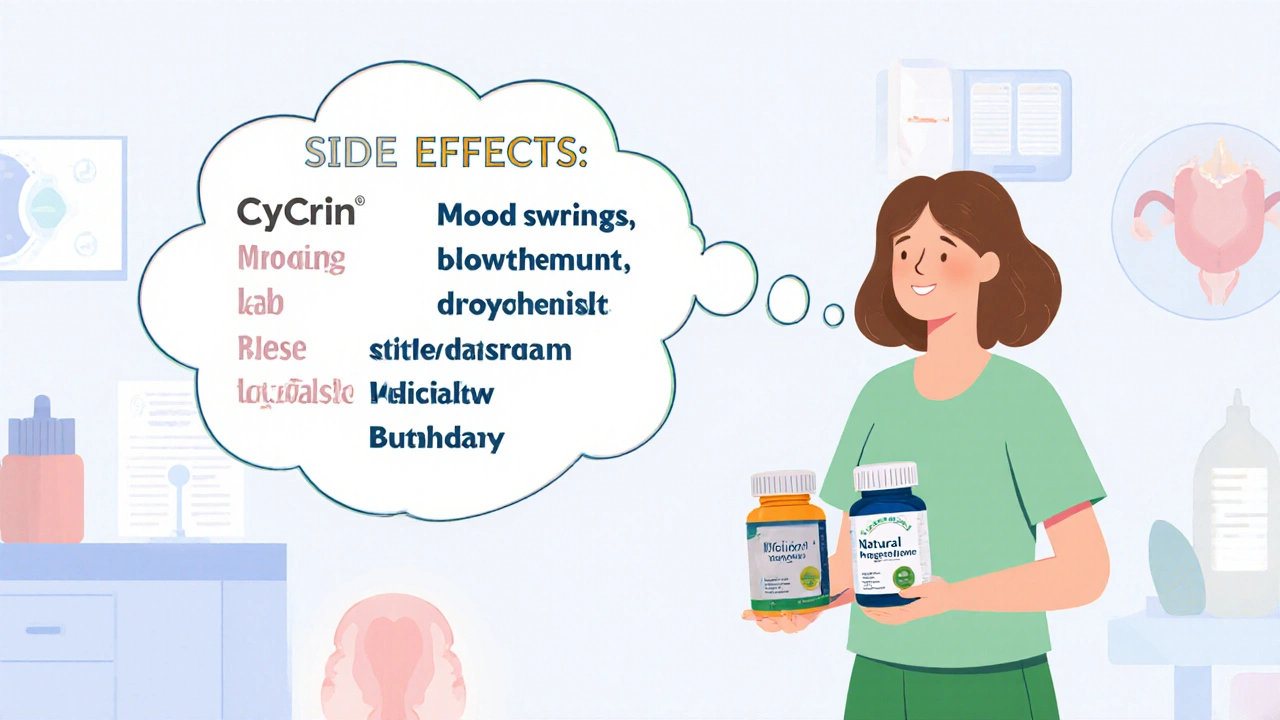Hormonal Treatment Comparison Tool
Find Your Best Cycrin Alternative
Select your primary concern to see which alternatives are most appropriate for you.
When your doctor recommends Cycrin (medroxyprogesterone), it’s usually because you need hormonal support - whether for irregular periods, endometriosis, menopause symptoms, or birth control. But Cycrin isn’t the only option. Many people wonder: Cycrin is effective, but are there better, safer, or more convenient alternatives? The answer depends on your body, your goals, and your tolerance for side effects.
What Cycrin Actually Does
Cycrin is a brand name for medroxyprogesterone acetate, a synthetic form of progesterone. It’s not the same as natural progesterone. It’s stronger, longer-lasting, and works differently in your body. Doctors prescribe it to:
- Regulate menstrual cycles in women with PCOS or amenorrhea
- Reduce heavy bleeding during periods
- Treat endometriosis by thinning the uterine lining
- Help manage menopause symptoms when used with estrogen
- Act as a long-term contraceptive (Depo-Provera shot is the same drug)
It’s taken orally, usually once a day for 5-10 days per month. The effects kick in fast - many notice changes in bleeding within the first cycle. But side effects are common: bloating, mood swings, weight gain, headaches, and spotting between periods. For some, these side effects are unbearable.
Why People Look for Alternatives
People stop taking Cycrin for three main reasons:
- Side effects feel worse than the original problem
- They want something more natural or less synthetic
- They need a different delivery method (like a patch or IUD instead of a pill)
A 2023 study in the Journal of Women’s Health found that nearly 40% of women prescribed medroxyprogesterone discontinued it within six months due to side effects. That’s a high dropout rate. If you’re struggling with Cycrin, you’re not alone - and there are other choices.
Alternative #1: Natural Progesterone (Micronized)
Unlike Cycrin, natural progesterone is chemically identical to what your body makes. It’s called micronized progesterone, sold under brands like Prometrium or Utrogestan. It’s made from plant sources (like soy or yams) and then modified to match human progesterone.
Here’s how it stacks up:
| Feature | Cycrin (Medroxyprogesterone) | Natural Progesterone (Micronized) |
|---|---|---|
| Source | Synthetic | Plant-derived, identical to human hormone |
| Side effects | Higher risk of mood swings, bloating, weight gain | Milder: drowsiness, breast tenderness |
| Effect on mood | Can worsen anxiety or depression | Often improves mood, less likely to cause irritability |
| Dosing | Once daily, usually 5-10 days/month | Usually taken at night due to drowsiness |
| Use in pregnancy | Not recommended | Commonly used in early pregnancy support |
Natural progesterone is often preferred for women who are sensitive to synthetic hormones. It’s also the go-to for those trying to conceive or managing early pregnancy. But it’s more expensive and not always covered by insurance. You also need to take it at night - it makes you sleepy.
Alternative #2: Progestin IUDs (Mirena, Kyleena, Liletta)
If you’re using Cycrin to control heavy periods or endometriosis, an IUD might be a game-changer. Mirena and similar devices release a low dose of levonorgestrel - a progestin - directly into the uterus.
Why it’s better for some:
- Works locally - less hormone enters your bloodstream
- Reduces or stops periods entirely for many users
- Effective for 3-8 years depending on the brand
- No daily pill to remember
A 2024 review in Obstetrics & Gynecology showed that 90% of women with heavy menstrual bleeding saw a 90%+ reduction in flow after 6 months on a progestin IUD. Many stopped bleeding altogether.
Downsides? Insertion can be uncomfortable. Some get spotting for the first 3-6 months. There’s a small risk of expulsion or perforation. But for women who want long-term relief without daily pills, this is often the most effective option.

Alternative #3: Combined Hormonal Birth Control (Pill, Patch, Ring)
If you’re taking Cycrin for cycle regulation or birth control, a combined hormonal method might be a smoother fit. These contain estrogen + progestin and are designed to mimic your natural cycle.
They’re especially helpful if you have:
- Irregular or absent periods
- Acne or excess hair growth (common in PCOS)
- Need contraception along with cycle control
Brands like Loestrin, Yaz, or the patch (Ortho Evra) offer more consistent hormone levels than Cycrin. That means fewer mood swings and less breakthrough bleeding.
But estrogen isn’t for everyone. If you have high blood pressure, migraines with aura, a history of blood clots, or are over 35 and smoke, combined methods aren’t safe. That’s where Cycrin or progestin-only options win.
Alternative #4: GnRH Agonists (Lupron, Synarel)
For severe endometriosis or fibroids, doctors sometimes turn to GnRH agonists. These drugs shut down your ovaries temporarily, creating a short-term menopause-like state.
They’re powerful. Pain often drops dramatically within weeks. But they come with serious side effects: bone loss, hot flashes, vaginal dryness, and mood changes. They’re only approved for 6 months at a time - sometimes longer with add-back therapy (low-dose estrogen or progesterone to protect bones).
Compared to Cycrin, GnRH agonists are a sledgehammer. Cycrin is a scalpel. If you’ve tried Cycrin and still have pain, this might be the next step - but only after discussing risks with your doctor.
Alternative #5: Non-Hormonal Options
Not everyone wants hormones at all. For heavy bleeding, tranexamic acid (Lysteda) is a non-hormonal pill that reduces blood loss by helping clots form. It’s taken only during your period - not every day.
For endometriosis pain, NSAIDs like ibuprofen or naproxen can help, especially if taken early in your cycle. Some women also use pelvic floor physical therapy or acupuncture to manage symptoms.
These won’t regulate your cycle like Cycrin, but they’re great for symptom relief without affecting hormones. They’re also safe for people who can’t take estrogen or progestin.

How to Choose the Right Alternative
There’s no single best option. Your choice depends on:
- Your goal: Is it birth control? Reducing bleeding? Managing pain? Each alternative excels in different areas.
- Your health history: Do you have blood clots, liver issues, or depression? Some options are risky.
- Your lifestyle: Can you remember a daily pill? Do you want something long-term?
- Your tolerance for side effects: Are you okay with spotting? Drowsiness? Weight gain?
Here’s a quick guide:
- Best for minimal side effects: Natural progesterone
- Best for long-term, low-maintenance control: Progestin IUD
- Best for acne and cycle regularity: Combined birth control
- Best for severe pain unresponsive to other treatments: GnRH agonists (short-term)
- Best for no hormones at all: Tranexamic acid + NSAIDs
What to Ask Your Doctor
Before switching from Cycrin, have this conversation:
- Why was Cycrin chosen for me in the first place?
- What’s the goal - control bleeding, prevent pregnancy, reduce pain?
- What are the risks of each alternative based on my health?
- Can I try one alternative at a time to see what works?
- Will my insurance cover it? What’s the out-of-pocket cost?
Don’t feel pressured to stay on Cycrin if it’s making you feel worse. Many women feel guilty for stopping - but your body’s comfort matters just as much as the prescription.
Final Thoughts
Cycrin works - but it’s not the only way. The best treatment is the one you can stick with. If side effects are dragging you down, it’s not a failure. It’s a signal. Your body is telling you it needs something different.
Switching to natural progesterone, an IUD, or even non-hormonal options can be life-changing. Many women report feeling like themselves again after making the change. Talk to your doctor. Try one alternative. Give it time. You deserve a treatment that fits your life - not the other way around.
Is Cycrin the same as progesterone?
No. Cycrin is medroxyprogesterone acetate, a synthetic hormone that mimics progesterone but is chemically different. Natural progesterone (like Prometrium) is identical to what your body produces. Cycrin is stronger and has more side effects, especially on mood and weight.
Can I switch from Cycrin to natural progesterone on my own?
No. Stopping Cycrin abruptly can cause withdrawal bleeding or hormonal imbalance. Always work with your doctor to taper off and start a new treatment. They’ll help you time the switch to avoid side effects like spotting or cramping.
Does Cycrin cause weight gain?
Yes, weight gain is a common side effect. Studies show women on medroxyprogesterone gain an average of 2-5 kg (4-11 lbs) in the first year, mostly due to water retention and increased appetite. Natural progesterone and progestin IUDs are less likely to cause this.
Which alternative is safest for long-term use?
The progestin IUD is the safest for long-term use. It delivers hormone directly to the uterus, so your body gets less overall exposure. Natural progesterone is also safe long-term, especially if you’re not estrogen-sensitive. Cycrin and GnRH agonists are not recommended for use beyond 6-12 months without breaks.
Can I use alternatives if I’m trying to get pregnant?
Yes - but not all. Natural progesterone is commonly used to support early pregnancy. Progestin IUDs must be removed before trying to conceive. Cycrin is not used during pregnancy. Combined birth control stops ovulation, so you need to stop it and wait a cycle before trying. Always check with your doctor before switching if pregnancy is a goal.










